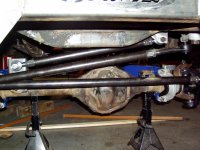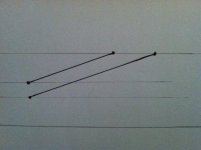Well, I made sure my drag link connection was pointing toward the bumper. It was a little more straight. I adjusted that.
Good. You can also play with this adjustment for another reason. Aligning the draglink to be more parallel with the trackbar, which helps answer your questions below.
I also noticed as I had my son turning the wheel back and forth a very small amount of flex on the drop bar bracket. I only welded it on the top (plus bolted it). It seems to be flexing... albiet a tiny amount.
AS you guessed, this is enough to cause some mild wandering all on it's own. Add that to something else being loose or wrong and it's one more thing against you.
But don't weld it just yet. More on that below.
I am going to weld that in along the bottom where it should be welded. I was apprehensive to commit to the FULL weld in for fear I did not have it correct, or needed a different one... but it very well may be a culprit.
Absolutely correct. So once again, make sure you can make things as close to parallel as you can before welding. If you need to change to a different bracket, now's the time to find out vs after you've just done a truly bitchin' once in a lifetime stack-o-dimes super weld.;D
I suppose if just turning the wheel causes a small amount of movement.... going down the road may see more pressure and therefore movement.
Exactly right. The power of the steering system is a real help in determining what moves and what shouldn't in static form. Add the weight shift of a moving vehicle and all that, and you're right to expect some funky monkey motions from a flexing trackbar or bracket.
Thanks for the tip Vcyota! However, my bars are not perfectly parallel.. they are close... but I see no real way to make them absolutely perfect. I will make those measurements though. Im curious using your method what I will get.
It's an excellent method in fact! Don't think I've ever seen anyone post that up in all these years. We usually talk about imaginary straight lines, or using string, or something like that. The one posted is elegantly simple and probably quicker and more accurate anyway. No more standing back to visualize your handywork!
And the way you "adjust" the angles is through things we've been discussing. Making sure that your pitman arm and trackbar bracket are as compatible as they can be, and make sure that you utilize as much of that rotating the tie-rod adjustment as you reasonably can, before you angle it up or down too much. There's a fair amount of leeway here though, so you can often achieve nirvana with what you've got.
And speaking of "what you've got" there buddy. We need to see some pics of your setup so we know that we're giving you the best advice we can. You're a paid contributor now, so click away and post up! Doesn't have to the the full monte centerfold spread. But a good frontal view of your steering setup would be nice.
Now, an issue that has not been discussed yet... but I see it has been brought up in other "chaser's of a straight driving Bronco" threads. Tire PSI. My tires are very near the size of a true 35x12x18 tire. (just a tiny bit smaller).
We're still running on empty info here. What EXACT tire size are you running? Spell it out for us and post up what the sidewall says for "max pressure" and "max load" for your tire.
Wheel size is good to know too, if you know what you have.
I am running 60lbs of air. I am starting to think I need to air WAY down to around 30lbs as i read about others who have had positive results after doing so.
It's a good place to start, but every setup is different on every truck, so it's up to you to do the experimenting long-term to get the best results.
However, since most of us that have posted up results do fall into that 28-32 psi front, and 24-30 psi rear category, it's a good bet that starting there will get you some results you can work with.
Not sure why as I have not seen a clear explanation... but i guess a more flexible sidewall stabilizes??? Seems like a crutch fix... but I'm game if it works! Any thoughts?
There's nothing "crutch" about any of what we're talking about here. A fix is a fix! You're dealing with a vehicle that no longer has any even remotely reasonable relationship to how it was shipped from the factory other than how it looks. And even that might have been changed in many cases.
The weight, the balance/bias, the power, the size of the tires and the dynamic performance of the suspension and likely the brakes have all been changed radically on most of our trucks. So there's no reason to think that tire air pressures should stay the same either.
And since you NEVER blindly go by the "maximum safe pressure" listings on the side of a tire, you need to think things through, throughout all of this back and forth dance of creating a new balance for your individual vehicle.
Tire air pressures are based on wheel width, tire diameter, tire carcass design, tread design and sidewall profile and the usual etceteras of vehicle overall weight, front-to-rear bias, expected use and all that.
It's not a flexier sidewall stabilizes things, it's that an overinflated tire is literally riding on the center of the tire. Just as an underinflated tire is riding on the two edges.
The manufacturers of the vehicle base their recommended tire pressures on the particulars of an individual vehicle, shipped from the factory with a specific tire and wheel combination, for general safety and good tread wear. The listing on the side of a tire is it's maximum safe inflation level and the maximum load each tire should carry at that maximum pressure. Nothing more.
The heavier duty a tire, typically the more max pressure is allowed and the more weight it can carry at that inflation. If the max on the sidewall of your probably metric truck tire is say, 65 psi with a max load of 2550 or something, that means that at 65 psi your tires can safely carry 10,200 lbs. More than double the weight of your Bronco!
On the flip side of that, if Ford recommended 30 psi front and rear, that was with the original tires. And since there were optional tire and wheel combos, it's very likely there were different pressure ratings for the different tires too. When mounted on a Bronco anyway. Same tire on a different truck might have had a different recommended pressure. All very likely to be somewhat below the max range on the sidewall.
But the original recommendations went out the window with all the changes. They simply become a reference point that is fairly close to what you might end up with.
There is a minimum safe pressure for every combo too of course, but that's usually not listed anywhere. They figure we can all read the listings (when there are listings that is) and they hope we can read the telltale signs of an underinflated (or overinflated) tire.
Poor handling being the primary indicator, with poor tire wear being the secondary indicator.
Paul













